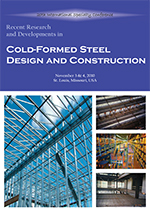Session Dates
03 Nov 2010
Abstract
The objective of this paper is to summarize efforts in a multi year project dedicated to developing a reliable design method for cold - formed steel wall studs that rely on sheathing for bracing. Testing on single columns with sheathing, and full - scale walls with sheathin g, are summarized. Particular emphasis is placed on the observed limit states given the different sheathing conditions. The sheathing supplies beneficial restraint to the wall studs and the stiffness of this sheathing - based restraint is characterized exper imentally and analytically. A unique application of the Direct Strength Method of design is explored where the sheathing - based restraint is used explicitly in determination of the elastic buckling loads of the wall studs, and then these elastic buckling lo ads are utilized to determine the strength. The test results are compared with the newly proposed design method as well as with previous design methods adopted by the AISI Specification. Good agreement is demonstrated for the new approach both in terms of strength an d limit states prediction.
Department(s)
Civil, Architectural and Environmental Engineering
Research Center/Lab(s)
Wei-Wen Yu Center for Cold-Formed Steel Structures
Meeting Name
20th International Specialty Conference on Cold-Formed Steel Structures
Publisher
Missouri University of Science and Technology
Document Version
Final Version
Rights
© 2010 Missouri University of Science and Technology, All rights reserved.
Document Type
Article - Conference proceedings
File Type
text
Language
English
Recommended Citation
Vieira, L. C. M. Jr. and Schafer, B. W., "Behavior and Design of Axially Compressed Sheathed Wall Studs" (2010). CCFSS Proceedings of International Specialty Conference on Cold-Formed Steel Structures (1971 - 2018). 2.
https://scholarsmine.mst.edu/isccss/20iccfss/20iccfss-session10/2
Behavior and Design of Axially Compressed Sheathed Wall Studs
The objective of this paper is to summarize efforts in a multi year project dedicated to developing a reliable design method for cold - formed steel wall studs that rely on sheathing for bracing. Testing on single columns with sheathing, and full - scale walls with sheathin g, are summarized. Particular emphasis is placed on the observed limit states given the different sheathing conditions. The sheathing supplies beneficial restraint to the wall studs and the stiffness of this sheathing - based restraint is characterized exper imentally and analytically. A unique application of the Direct Strength Method of design is explored where the sheathing - based restraint is used explicitly in determination of the elastic buckling loads of the wall studs, and then these elastic buckling lo ads are utilized to determine the strength. The test results are compared with the newly proposed design method as well as with previous design methods adopted by the AISI Specification. Good agreement is demonstrated for the new approach both in terms of strength an d limit states prediction.



